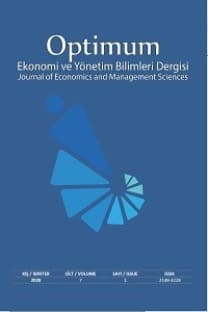TL / ABD Doları Döviz Kuru Belirlenme Modeli: ARDL Sınır Testi Uygulaması
Döviz kurlarının uzun dönemli gelişim süreçlerinin tahmin edilmesi hem gelişmiş hem de gelişmekte ekonomilerde uygulanan politikaların etkinlik koşulları açısından belirleyici bir işleve sahip olacaktır. Bu makalede bir döviz kuru belirlenme modeli kapsamında TL / ABD doları 2005Q4-2018Q3 gözlem dönemi için incelenmeye çalışılmaktadır. Kuramsal bir yaklaşım izlenerek parasal model döviz kuru belirlenme mekanizması ortaya konmuş ve ARDL sınır testi eşbütünleşim yöntemi ile tahmin edilmiştir. Bulgular parasal döviz kurunun iktisat kuramının belirttiği temeller ile tutarlı bir şekilde eşbütünleşik bir ilişkiye sahip olduğunu belirtmektedir. Parasal döviz kuru göreceli para arzı ile pozitif bir etkileşim içerisindeyken göreceli reel gelir düzeyindeki bir artış ulusal para biriminin ABD doları karşısında değer kazanması ile sonuçlanmaktadır. Ayrıca, önsel olarak varsayıldığı gibi, parasal döviz kuruyla göreceli faiz oranı arasında negatif ve göreceli beklenen enflasyon oranı arasında pozitif bir ilişki bulunmuştur.
Anahtar Kelimeler:
Döviz Kuru, İktisadi Temeller, Modelleme
Exchange Rate Determination Model of TL / US Dollar: ARDL Bounds Testing Application
Estimating the long run movement of the exchange rates has a determining role for the efficiency of policies in both the developed and the developing economies. In this paper, exchange rate determination mechanism of TL / US dollar is tried to be examined for the 2005Q3-2018Q3 period. By following a theoretical base, the monetary model exchange rate determination mechanism has been constructed, and estimated with ARDL model bounds testing cointegration methodology. The results indicate that nominal exchange rate is cointegrated with the fundamentals suggested by economics theory. There exists a positive relationship between nominal exchange rate and relative money supply and that an increase in the relative income would lead to an appreciation of the domestic currency against the US dollar. Besides, as a priori hypothesized, relative interest variable has a negative relationship and relative inflation differential has a positive relationship with the nominal exchange rate.
Keywords:
Exchange Rate, Economic Fundamentals, Modelling,
___
- Abhyankar, A., Sarno, L. & Valente, G. (2005). Exchange rates and fundamentals: evidence on the economic value of predictability. Journal of International Economics, 66, 325-348.
- Afat, D., Gómez-Puig, M. & Sosvilla-Rivero, S. (2015). The failure of the monetary model of exchange rate determination. Applied Economics, 47(43), 4607-4629.
- Bahmani-Oskooee, M. & Kara, O. (2000). Exchange rate overshooting in Turkey. Economics Letters, 68, 89- 93.
- Chin, L., Azali, M. & Matthews, K.G. (2007). The monetary approach to echange rate determination for Malaysia. Applied Financial Economics Letters, 3(2), 91-94.
- Civcir, İ. (2004). The long-run validity of the monetary exchange rate model for a high inflation countryand misalignment: The case of Turkey. Emerging Markets Finance and Trade, 40(4), 84-100.
- Engle, R.F. & Granger, C.W.J. (1987). Co-integration and error correction: representation, estimation, and testing. Econometrica, 55, 251-276.
- https://stats.oecd.org/, erişim tarihi: 06.12.2018.
- https://www.sbb.gov.tr/, erişim tarihi: 06.12.2018.
- Johansen, S. (1995). Likelihood-based inference in cointegrated vector autoregressive models. Oxford: Oxford University Press.
- Karfakis, C. (2006). Is there an empirical link between the dollar price of the euro and the monetary fundamentals?. Applied Financial Economics, 16, 973-980.
- Lee, J. & Strazicich, M.C. (2003). Minimum lagrange multiplier unit root test with two structural breaks. The Review of Economics and Statistics, 85(4), 1082-089.
- Mark, N.C. & Sul, D. (2001). Nominal exchange rates and monetary fundamentals evidence from a small post-Bretton woods panel. Journal of International Economics, 53, 29-52.
- Meese, R. A. & Rogoff, K. (1983). Empirical exchange rate models of the seventies: Do they fit out of sample?. Journal of International Economics, 14(1-2), 3-24.
- Neely, C.J. & Sarno, L. (2002). How well do monetary fundamentals forecast exchange rates?. FRB of St. Louis Review, September/October, 51-74.
- Ozdemir, Z.A. (2004). Mean reversion in real exchange rate: empirical evidence from Turkey, 1980-1999. METU Studies in Development, 31, 243-265.
- Pesaran, M.H., Shin, Y. & Smith, R.J. (2001). Bounds testing approaches to the analysis of level relationships. Journal of Applied Econometrics, 16, 289-326.
- Shylajan, C.S., Sereejesh, S. & Suresh, K.G. (2011). Rupee-dollar exchange rate and macroeconomic fundamentals: An empirical analysis using flexible-price monetary model, Journal of International Business and Economy, 12(2), 89-105.
- Uz, İ. and Ketenci, N. (2010). Exchange rate determination: Monetary approach in the new EU members and Turkey. Applied Economics Letters, 17(10), 963-967.
- Yayın Aralığı: Yılda 2 Sayı
- Başlangıç: 2014
- Yayıncı: -
Sayıdaki Diğer Makaleler
Bulanık Parçacık Sürü Optimizasyon Yaklaşımı Temelli Kümeleme
Adalet Hizmetlerinde Beklenti Çıpası ve Beklenti Yanlışlaması Hipotezleri: Türkiye Örneği
Sevilay Ece GÜMÜŞ ÖZUYAR, Alparslan Abdurrahman BAŞARAN, Necmiddin BAĞDADİOĞLU
TL / ABD Doları Döviz Kuru Belirlenme Modeli: ARDL Sınır Testi Uygulaması
Sayıştayların Denetlenmesi: Ülke Uygulamaları ve Türkiye
Post Keynesyen Ekonominin Metodolojik Temelleri
Orta Gelir Tuzağının Türkiye Geneli ve Düzey Alt Bölgeleri İçin Tespiti
